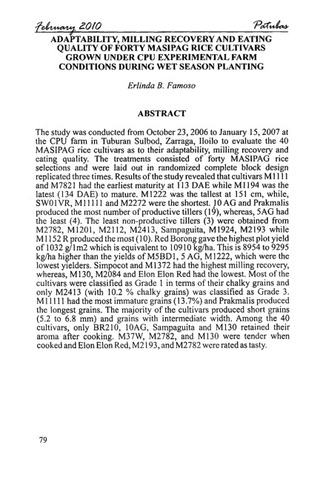Adaptability, milling recovery and eating quality of forty MASIPAG rice cultivars grown under CPU experimental farm conditions during wet season planting
| dc.contributor.author | Famoso, Erlinda B. | |
| dc.date.accessioned | 2021-04-12T07:21:50Z | |
| dc.date.available | 2021-04-12T07:21:50Z | |
| dc.date.issued | 2010-02 | |
| dc.identifier.citation | Famoso, E. B. (2010). Adaptability, milling recovery and eating quality of forty masipag rice cultivars grown under CPU experimental farm conditions during wet season planting. Patubas, 8(1), 79-106 | en_US |
| dc.identifier.issn | 1908-515X | |
| dc.identifier.uri | https://hdl.handle.net/20.500.12852/765 | |
| dc.description | Abstract only | en_US |
| dc.description.abstract | The study was conducted from October 23, 2006 to January 15, 2007 at the CPU farm in Tuburan Sulbod, Zarraga, Iloilo to evaluate the 40 MASIPAG rice cultivars as to their adaptability, milling recovery and eating quality. The treatments consisted of forty MASIPAG rice selections and were laid out in randomized complete block design replicated three times. Results of the study revealed that cultivars M1111 and M7821 had the earliest maturity at 113 DAE while Ml 194 was the latest (134 DAE) to mature. M1222 was the tallest at 151 cm, while, SW01VR, M1111 and M2272 were the shortest. 10 AG and Prakmalis produced the most number of productive tillers (19), whereas, 5AG had the least (4). The least non-productive tillers (3) were obtained from M2782, M1201, M2112, M2413, Sampaguita, M1924, M2193 while M1152 R produced the most (10). Red Borong gave the highest plot yield of 1032 g/1m2 which is equivalent to 10910kg/ha. This is 8954 to 9295 kg/ha higher than the yields of M5BD1, 5 AG, M1222, which were the lowest yielders. Simpocot and M1372 had the highest milling recovery, whereas, M130, M2084 and Elon Elon Red had the lowest. Most of the cultivars were classified as Grade 1 in terms of their chalky grains and only M2413 (with 10.2 % chalky grains) was classified as Grade 3. M11111 had the most immature grains (13.7%) and Prakmalis produced the longest grains. The majority of the cultivars produced short grains (5.2 to 6.8 mm) and grains with intermediate width. Among the 40 cultivars, only BR210, 10AG, Sampaguita and M130 retained their aroma after cooking. M37W, M2782, and M130 were tender when cooked and Elon Elon Red, M2193, and M2782 were rated as tasty. | en_US |
| dc.language.iso | en | en_US |
| dc.publisher | Central Philippine University | en_US |
| dc.rights | Attribution-NonCommercial-NoDerivs 3.0 Philippines | * |
| dc.rights.uri | http://creativecommons.org/licenses/by-nc-nd/3.0/ph/ | * |
| dc.subject.lcsh | Rice | en_US |
| dc.subject.lcsh | Rice--Varieties | en_US |
| dc.subject.lcsh | Rice--Varieties--Testing | en_US |
| dc.subject.lcsh | Food--Sensory evaluation | en_US |
| dc.subject.lcsh | Rice--Sensory evaluation | en_US |
| dc.subject.lcsh | Rice--Milling | en_US |
| dc.title | Adaptability, milling recovery and eating quality of forty MASIPAG rice cultivars grown under CPU experimental farm conditions during wet season planting | en_US |
| dc.title.alternative | Adaptability, milling recovery and eating quality of forty MASIPAG rice cultivars grown under Central Philippine University experimental farm conditions during wet season planting | en_US |
| dc.type | Article | en_US |
| dc.citation.firstpage | 79 | en_US |
| dc.citation.lastpage | 106 | en_US |
| dc.citation.journaltitle | Patubas | en_US |
| dc.citation.volume | 5 | en_US |
| dc.citation.issue | 1 | en_US |
| local.subject.scientificname | Oryza sativa | en_US |
Files in this item
This item appears in the following Collection(s)
-
Journal articles [25]
-
Patubas [109]
Patubas is a refereed research journal of Central Philippine University.



